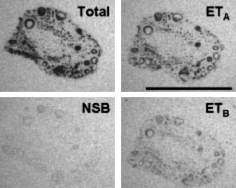Print version
Search Pub Med
Characterisation of endothelin receptor sub-types in pulmonary endarterectomy (PEA) specimens from patients with chronic thromboembolic pulmonary hypertension (CTEPH) Endothelin-1 (ET) is a potent vasoconstrictor and promotes endothelial and smooth muscle cell proliferation (Davenport & Maguire, 2006). In human coronary arteries we have previously shown that recanalisation of thrombus is characterised by formation of new vessels which show intense endothelial ET-like immunoreactivity with ETA but not ETB receptors on the smooth muscle of recanalised vessels (Bacon et. al. 1996). In patients with CTEPH, ET levels fall post-PEA and in some CTEPH patients additional use of ET receptor antagonists is of benefit. However, little is known regarding the role of ET in CTEPH. In excised PEA specimens there are often focal areas of recanalisation containing endothelialised channels surrounded by smooth muscle cells (SMCs). Our aim, using standard immunocytochemistry and autoradiography techniques (Davenport & Kuc, 2005); was to determine the distribution and localisation of both ET receptor subtypes in PEA specimens. PEA specimens (n = 19 patients) comprising a proportion of the pulmonary artery intima and all intraluminal material was obtained with local ethical approval and informed consent from patients undergoing PEA for CTEPH. Representative samples of distal and proximal PEA specimens were snap-frozen in liquid nitrogen and cryosectioned. The autoradiographical distribution of all ET receptors was determined by incubating sections for 2 h at 23oC with [125I]-ET-1 (0.1nM). ETA receptors were visualized by incubating adjacent sections with [125I]-ET-1 (0.1nM) in the presence of either 0.1µM BQ3020 (a concentration calculated to block binding of the radiolabel to the ETB subtype) or 0.1µM BQ123 to detect ETB. Non-specific binding was defined by incubating a further adjacent section with the radioligand in the presence of unlabelled ET-1 (1µM). ETA and ETB specific antisera were used in subsequent sections to further determine receptor subtype expression with co-localisation to specific cell markers using anti-SMA (smooth muscle cells) or anti-vWF and anti-CD31 (endothelial cells). Specimens were categorised, based on morphology as highly organized, partially organized or fresh thrombus. In highly organized thrombi containing recanalised channels each recapitulated the histological architecture of an artery with a distinct endothelial cell layer (CD31 positive) surrounded by arranged contractile (fusiform) SMCs. Using quantitative autoradiography ETA receptors predominated and were associated with the recanalised vessels, being present on medial (contractile) SMCs. This cellular distribution was confirmed by confocal microscopy. ETB receptors were present on endothelial cells as expected. Partially organized thrombi consisted of abundant fibromyxoid granulation tissue with admixed SMCs predominantly of a morphologically secretory phenotype (short, stellate cells) with occasional dispersed contractile SMCs and no recanalised channels. Some ET binding was visualised in the fibromyxoid thrombus core but this did not localise with the SMCs. ET receptors could not be detected in fresh thrombus.
Figure 1. Autoradiogram showing ET receptor distribution in PEA sample. Our results indicate that ET receptors are present on contractile SMCs observed surrounding recanalised channels in fully organised thrombus but not in the secretory SMCs of partially organized thrombus. The abundance of ET receptors within PEA specimens provides evidence that the ET pathway is involved in the pathology of chronic thrombus reorganisation leading to CTEPH and provides a rationale for the repurposing of ET receptor antagonists in the treatment of this condition.
Davenport AP, Kuc RE. (2005) Receptor Binding Techniques. Humana Press, New Jersey,93-120. Davenport AP, Maguire JJ. (2006) Endothelin. Handbook of Experimental Pharmacology, 176, 295-329. Bacon CR, Cary NR, Davenport AP. (1996) Endothelin peptide and receptors in human atherosclerotic coronary artery and aorta. Circ Res. 1996 Oct;79(4):794-801.
|
|


